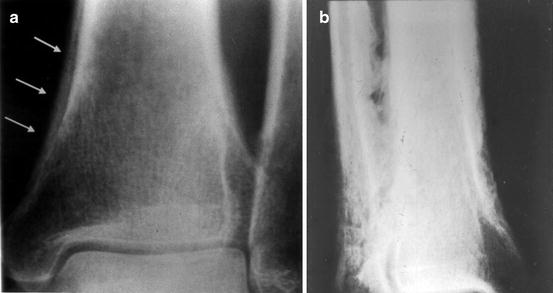Fig. 47.1
Digital clubbing: the bulbous deformity of the finger on the right is compared to the normal finger shape on the left

Fig. 47.2
(a) Early hypertrophic osteoarthropathy. Anterior-posterior view of the ankle, showing monolayer periosteal apposition on the tibial cortex (arrows). (b) Advanced periostosis. Anterior-posterior view of the ankle. Chunky irregular periosteal proliferation that generates bone thickening
HOA may be secondary to a severe internal illness such as cyanotic heart disease, lung cancer, chronic liver failure, or Graves’ disease, among many others. HOA can also be present as idiopathic or “primary” form that is also known as pachydermoperiostosis [2].
Physical examination is of foremost importance in diagnosis, because the bulbous deformity of the fingertips is unique (Fig. 47.1). Effusions into the large joints are frequently observed and are more easily detected in the knees and wrists.
Primary HOA is characterized by a clear-cut hereditary predisposition, with 33 % of cases having a close relative with the same illness. The male–female ratio is 9:1. Primary cases are prone to display a more disseminated skin hypertrophy, hence the term “pachydermoperiostosis.” This overgrowth roughens the facial features, and it can reach the extreme of cutis verticis gyrata, the most advanced stage of cutaneous hypertrophy. In such cases, the scalp takes on a cerebroid appearance. Another cutaneous alteration more frequently seen in idiopathic cases is glandular dysfunction manifested as hyperhidrosis, seborrhea, or acne [3].
Plain radiographs of the extremities may detect abnormalities in an asymptomatic patient; long-standing clubbing is characterized by a bone remodeling process that usually takes the form of acroosteolysis or more rarely tuftal overgrowth. Periosteal apposition has a symmetric distribution and evolves in a centripetal fashion (Fig. 47.2) [4].
Differential Diagnosis
Drumstick fingers are so unique that its recognition usually poses no dilemma. Diagnostic criteria for HOA are the combined presence of clubbing and radiographic evidence of periostosis of the tubular bones. Synovial effusion is not essential for the diagnosis. Nevertheless, it should be emphasized that in some patients – particularly those with malignant lung tumors – painful arthropathy may be the presenting manifestation of the syndrome in advance of clubbing. Such cases could be misdiagnosed as suffering from an inflammatory type of arthritis. Here, important clinical features in the differential diagnosis are the location of pain – in HOA not only the joint is involved but also the adjacent bone – plus the fact that rheumatoid factor is usually absent and synovial fluid is “noninflammatory” in nature.
Stay updated, free articles. Join our Telegram channel

Full access? Get Clinical Tree








